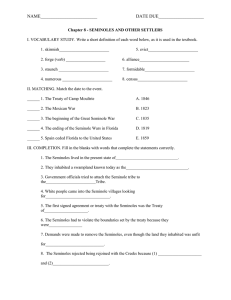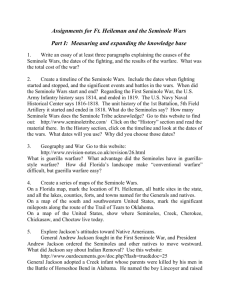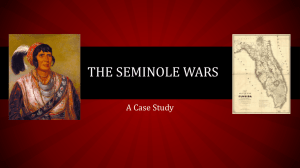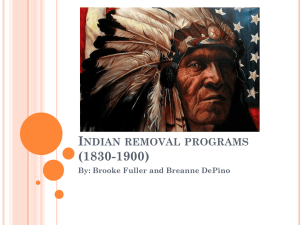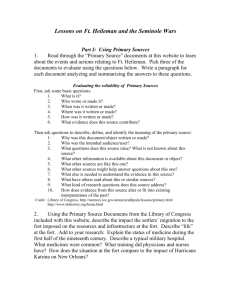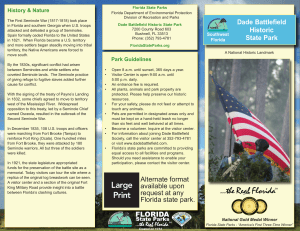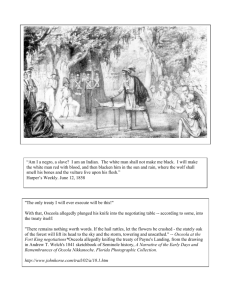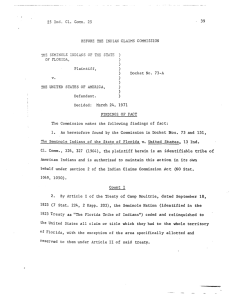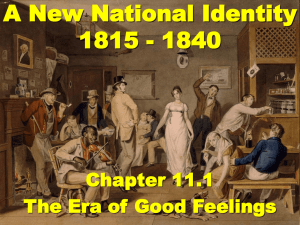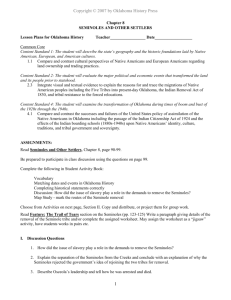to reading material. - Clay County Historical Archives
advertisement
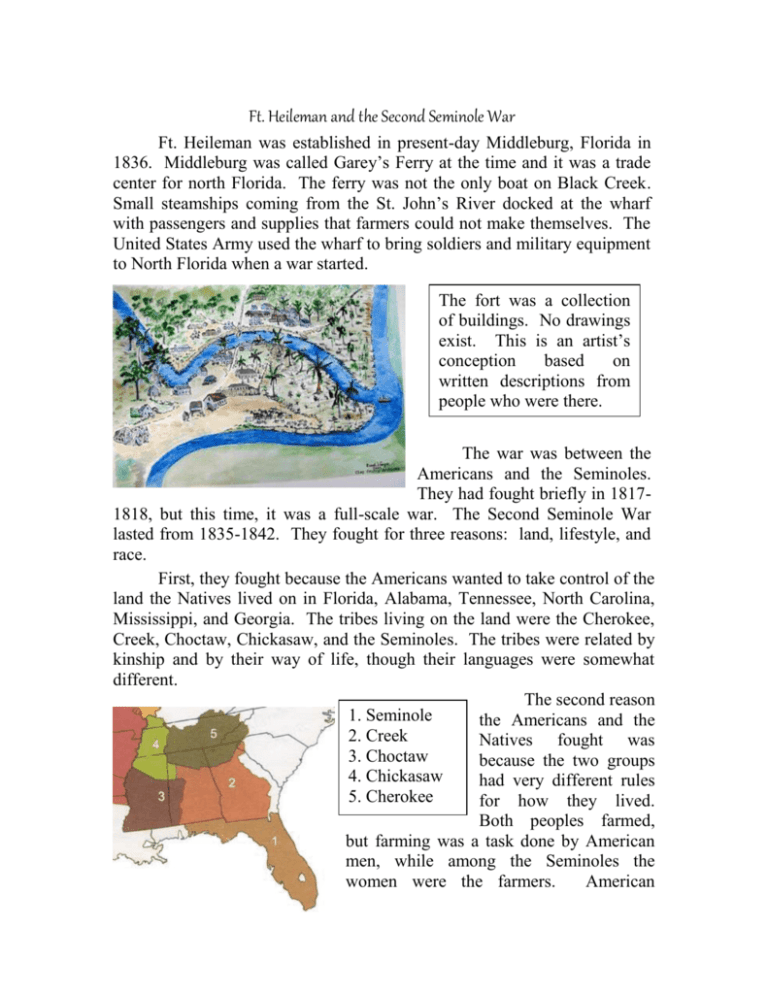
Ft. Heileman and the Second Seminole War Ft. Heileman was established in present-day Middleburg, Florida in 1836. Middleburg was called Garey’s Ferry at the time and it was a trade center for north Florida. The ferry was not the only boat on Black Creek. Small steamships coming from the St. John’s River docked at the wharf with passengers and supplies that farmers could not make themselves. The United States Army used the wharf to bring soldiers and military equipment to North Florida when a war started. The fort was a collection of buildings. No drawings exist. This is an artist’s conception based on written descriptions from people who were there. The war was between the Americans and the Seminoles. They had fought briefly in 18171818, but this time, it was a full-scale war. The Second Seminole War lasted from 1835-1842. They fought for three reasons: land, lifestyle, and race. First, they fought because the Americans wanted to take control of the land the Natives lived on in Florida, Alabama, Tennessee, North Carolina, Mississippi, and Georgia. The tribes living on the land were the Cherokee, Creek, Choctaw, Chickasaw, and the Seminoles. The tribes were related by kinship and by their way of life, though their languages were somewhat different. The second reason 1. Seminole the Americans and the 2. Creek Natives fought was 3. Choctaw because the two groups 4. Chickasaw had very different rules 5. Cherokee for how they lived. Both peoples farmed, but farming was a task done by American men, while among the Seminoles the women were the farmers. American women at that time could not vote, but Seminole women had a voice in decisions affecting the whole village. Only American men could be “head of the household,” but Seminole women made most of the decisions about the family. Seminole children did not attend schools but learned from their parents and other adults in the villages how to be good hunters and farmers, and how to make the weapons and tools they needed. The Cherokee, who lived in Georgia and were cousins of the Seminoles, had a written language and a Constitution similar to the United States Constitution, but the Seminole language was not written down and none of the Seminoles could read or write. The differences between the American way of life and the Native way of life made it hard for the two groups to do business together. The Natives did not believe anyone could “own” the land any more than anyone could “own” the sky. The Natives had Two boys, two examples of powerful chiefs, but no one spoke for all dressing up. The boy on the the Natives like the President of the left is Osceola. United States speaks for all Americans. The third reason the Americans and the Native Americans fought was because of American attitudes about race. Even when the Natives tried to live like the Americans, the Americans did not want them for neighbors because of their dark skin. The Seminoles welcomed African-American slaves who escaped bondage by running away to the Native villages. They became part of the community, married Seminoles, and lived according to Seminole community rules. Abraham was a Chief among the Black Seminoles. Most of the natives in four of the five tribes did not want to fight. They agreed to give up their land and move to the Indian Territory, which is now the state of Oklahoma. The Trail of Tears They had to walk, a journey of a thousand miles. Of the 14,000 people who began the trip, 4,000 of them died on the way. Their journey is called the “Trail of Tears.” Micanopy and Mad Wolf (Yaha-Hajo) were the two most powerful chieftains who opposed the American policy of “removal” to Oklahoma. Osceola was the most famous Seminole warrior. Micanopy Mad Wolf Osceola The two most famous United States Presidents during the Seminole Wars were Andrew Jackson and Martin Van Buren. Before Jackson became President, he was also a General and he fought against the Seminoles in the early years of the war. General Thomas S. Jessup commanded the troops in Florida for two years. He was replaced by General Taylor, who became President of the United States after the Seminole War ended. Andrew Jackson Martin Van Buren Zachary Taylor The worst of the fighting began when five Seminole chiefs signed an X by their names on the Treaty of Payne’s Landing. The treaty stated that the Seminoles would leave their land in Florida and move to Oklahoma. The problem was that the men who signed the treaty did not speak for all the Seminoles, including the most powerful chief, Micanopy. Micanopy, Osceola and over half of the 5,000 Seminoles in the State refused to move. American troops came to force them to leave their Jessup homes. Most of the fighting was in South Florida, but the Seminoles attacked farms across the Florida Panhandle as well. Even though no farms were attacked in Clay County, houses in nearby counties were burned, and the farmers and their families in Clay County were afraid. They went to Ft. Heileman for safety. The families moving into the area of the fort had to learn new rules for eating and sleeping, and how they spent their time during the day. The new rules for the people at Ft. Heileman were a lot like the rules people have to follow when there is a hurricane threatening Florida and families have to evacuate to schools, churches, and other public places. Families could only take a few of their belongings and possessions. They had to live in tents or shelters made of branches, with little privacy. Other families lived only a few feet away. They had to get in line to get their meals, like students today get in line in the cafeteria at school. Almost all of life took place outdoors. They couldn’t do the normal things they usually did during the day. They had no crops to tend or livestock to feed. Children could not go to school. Many people became ill and died. The physician at the fort did not have enough medical supplies, nor was there a hospital at the fort. One of the children who died was the baby son of Captain Samuel McRee. A poem titled “The Burial of an Infant in Florida” appeared in the Army and Navy Chronicle in 1840. I lay thee here my sinless one I put thee down to rest But not upon thine elder bed Nor on thy mother’s breast. Within this little grave they’ve scooped Far in the forest wild I lay thee here my precious one I leave thee here my child. The Second Seminole War lasted until 1842. The fort was abandoned that year because the fighting had stopped. When hostilities resumed in 1855, the fighting was largely confined to the southern region of the state. The United States government moved some of the soldiers who had died at the fort to the military cemetery in St. Augustine. United States Army records in the Library of Congress show that about three dozen veterans and an unknown number of citizens (including the Captain McRee’s baby son) remain buried at the fort’s cemetery. The Seminoles were not defeated, but the fighting finally stopped when most of them said they would go to Oklahoma. Not all of them left Florida, however. The Seminoles who stayed moved into the Everglades, where they have lived since the war ended. All Native Americans became United States citizens in 1924. In 1970 the United States government awarded the Seminoles $12,347,500 for the land they lost during the Seminole Wars. In 2002, the government awarded the Oklahoma Seminoles $55,000,000 for their lost land. Today the area where the fort was located is a park. Each year on Memorial Day, a service is held near the fort’s cemetery to honor the families and military veterans who died so that Florida could be settled by Americans.
